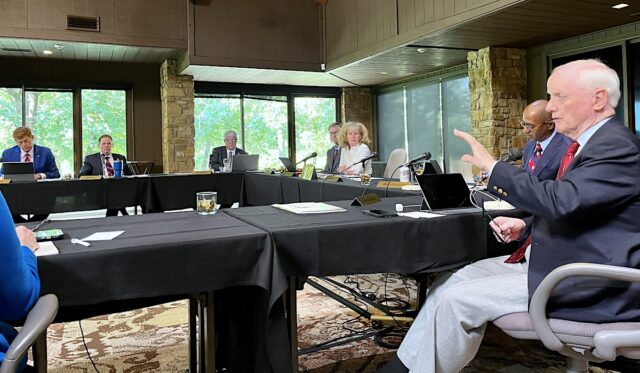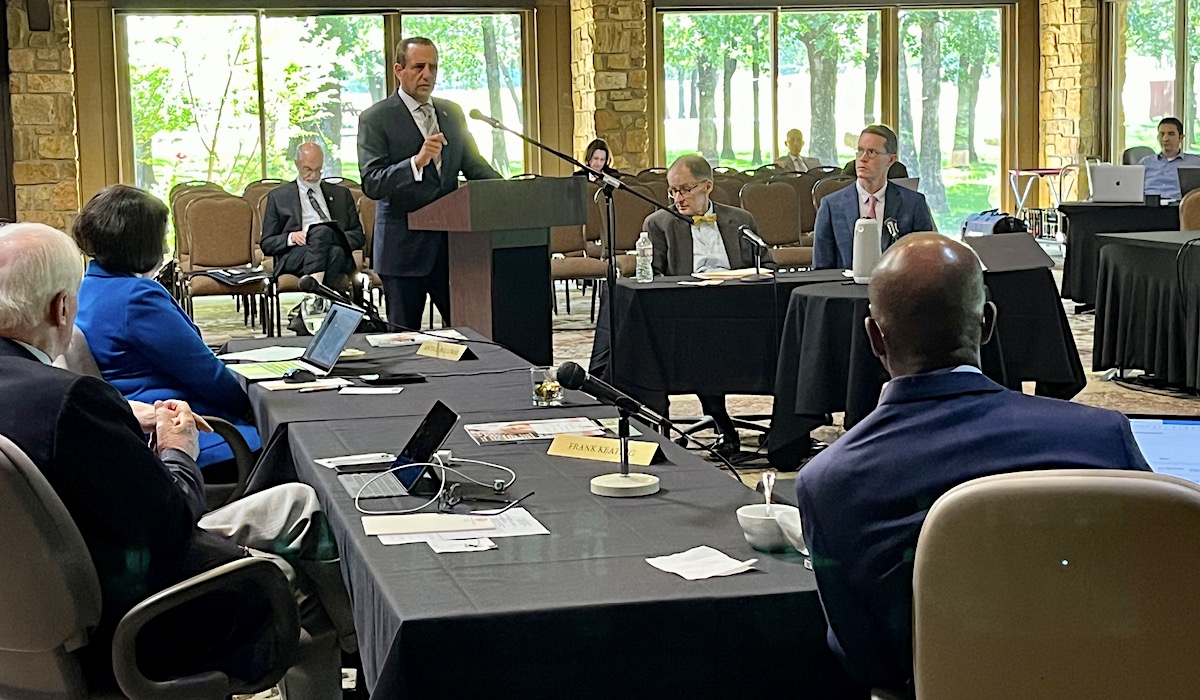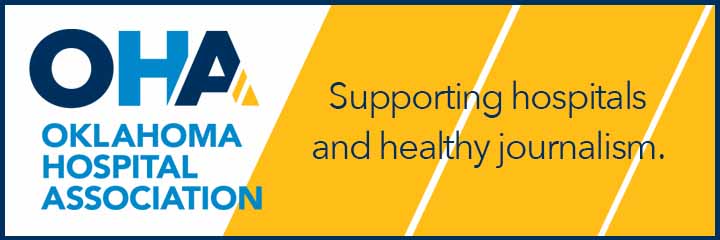
OSAGE COUNTY — During a nine-hour meeting to kick off its two-day “planning” retreat at a resort northwest of Tulsa, the University of Oklahoma Board of Regents approved a 3 percent increase in all OU undergraduate and College of Law student tuition while also discussing financial matters, debt concerns and national trends about changing enrollment demographics.
In-state students enrolled at the University of Oklahoma will pay about $283 more per year in tuition and fees, which Vice President for Budget and Finance Stewart Berkinshaw said equates to “less than $1 per day.” Students from other states will also see a 3 percent increase in their costs, which will equate to about $786 per year. Berkinshaw said “student organizations” supported the tuition increase, although he did not name any specifically.
Wednesday’s vote marks the third year in a row that the Board of Regents has approved an OU tuition increase, even as the Oklahoma Legislature has increased state appropriations for higher education. In 2021, regents approved a 2.75 percent increase on all OU undergraduate students. In 2022, regents surprised OU administrators by amending their tuition agenda item to approve a 3 percent increase only on out-of-state students.
OU President Joe Harroz told regents that overall costs for many in-state students have declined nearly 6 percent in recent years, largely owing to a 45 percent increase in need-based aid and scholarships over the past three years.
“How can you say the cost for an average Oklahoman has gone down 6 percent? And the answer is because of the infusion of additional aid to those individuals that are from this state — that 45 percent increase,” Harroz said. “So yes, there are some students who, without a doubt, are paying more, because we have to have that to fuel excellence under this [strategic plan]. Those students who can’t afford to pay? The answer is, ‘You won’t.’ Because both of those work together. And I’m really proud to be part of an institution where we have taken a hard look at costs, and this board started this before I got in this job.”
Harroz and regents also praised a pair of merit-based faculty and staff compensation plans developed over the past year for the Norman and Health Sciences Center campuses. The merit-based raises will be partially funded by the tuition increase, as well as about $8.8 million in new state appropriations. Raises will be larger for faculty than for staff on a percentage basis, and a merit component — based on supervisory evaluations — will modify employees’ raises, according to OU officials.
“The message from this board is crystal clear. Drive excellence to where it matters, and the merit-based increase this year? A huge step,” Harroz said. “This board gave us that challenge. It said clearly one year ago, ‘Don’t bring us another increase for salary unless it’s merit-based.’ It was a huge step, and it’s the right thing to do to move us forward.”
During last year’s June meeting of the board, regents approved merit-based compensation opportunities for Harroz, including the chance for an annual $100,000 lump-sum bonus that they granted him today. Cameron University President John McArthur and Rogers State University President Larry Rice each received a $25,990.60 bonus.
A 2.9 percent increase to Cameron tuition was also approved by regents, although McArthur said a fee reduction functionally makes the cost revenue-neutral to students.
At Rogers State, in-state students will see a 2 percent increase in tuition, and out-of-state students will see a 1 percent increase. Rice also received approval to establish a “block tuition” proposal similar to other institutions, but regents asked Rice to monitor the impact and make sure it does not dissuade possible students who intend to take fewer than the requisite credit hours for the block rate.
NIL rules, tailgating talk precede 2024 football schedule’s release

Besides tuition increases, regents also took action on a variety of other items, including an update of regents’ policy guidelines for Title IX sexual misconduct and discrimination reporting, as well as approving hundreds of millions of dollars of bond authorizations and matters related to student athletics.
Board members amended the university’s name, image and likeness policy after the Legislature overrode Gov. Kevin Stitt’s veto of a bill establishing new rules for NIL deals and the representation of student athletes. The new law allows people other than attorneys to represent athletes in NIL deals. Across the country, student athletes have joined collectives that are both for-profit and nonprofit to pursue NIL deals.
Regents amended OU’s NIL policy to make it consistent with the new state law.
“Bottom line is we have been very innovative, creative and, candidly, relentless in trying to pursue an NIL strategy, primarily because we’re always trying to elevate our student athletes and their experience in the University of Oklahoma,” OU Athletic Director Joe Castiglione told regents during the meeting. “(I) want to thank the state Legislature for amending the NIL law that we had in place, and it certainly makes it easier for us to explore those opportunities and partner with entities on or off campus on behalf of student athletes.”
Meanwhile, Castiglione and the broader collegiate athletic landscape are reviewing a 12-page memo released Friday by the IRS Office of Chief Counsel advising that donations to nonprofit NIL collectives should not be considered tax exempt.
“It is the view of this office that many organizations that develop paid NIL opportunities for student-athletes are not tax exempt and described in section 501(c)(3) because the private benefits they provide to student-athletes are not incidental both qualitatively and quantitatively to any exempt purpose furthered by that activity,” IRS Deputy Associate Chief Counsel Lynne A. Camillo wrote in the memo.
In the meeting today, Castiglione said he anticipated OU’s NIL activities “narrowing to two primary collective approaches” eventually:
- the Crimson and Cream Collective, which is not officially associated with the university and which does not have a charitable endeavor; and
- the Sooner Charitable Collective, which is officially associated with OU and which is intended to be charitable.
“It’s just on the threshold of getting started,” Castiglione said of Sooner Charitable Collective after the meeting. “So there’s no previous activity that they are concerned about. What they are looking at is whether the IRS memo should cause them to consider any changes that they didn’t anticipate prior. But I will tell you that I know they were absolutely intentional about making sure that they created their own charter and foundation and board that is separate and (to) make sure it aligned correctly with a charitable designation so that they could create activities for student athletes that are not an area of concern. So I’m not expecting anything, but they’re certainly just being extra careful to see if there’s something that they hadn’t considered since this is a new interpretation.”
Asked about the 1Oklahoma collective, which bills itself as “the only NIL-approved sponsor for The University of Oklahoma,” Castiglione said he was unsure of the IRS determination’s impact on that collective, which pairs OU athletes with local nonprofits.
“The 1Oklahoma collective was one of the first, and they did obtain a 501(c)(3) designation, but I can’t answer whether they are concerned or not. That has to be, literally, an individual assessment,” Castiglione said. “We don’t get to look at any of their books, we don’t know about all their transactions. We have no way of knowing that, whether any of the activities in any collective — and I think this would be similar for anyone around the country — they are the ones that should be looking what the IRS memo means to them.”
After the NIL policy change approval, regents authorized OU leaders to create a tailgate and major event day policy for the university, though few details of what the policy might ultimately include were given.
“One of the things we want to look at is the tailgating policy to ensure the best experience,” Harroz said, noting that the move from the Big 12 Conference to the Southeastern Conference has spurred the review. “The goal here is to expand tailgating in a way that [values] fun and safety.”
Saying they receive many inquiries and remarks about OU football tailgating, regent Eric Stevenson and regent Rick Nagel asked for regents to be able to “see” the tailgating policy after it’s created. As a result, Nagel amended the approval motion to require an informational presentation of the final policy to a pair of regent committees.
Harroz said after the meeting that many options are on the table tailgate, including areas along Lindsey Street.
Shortly after the regents’ nine-hour meeting concluded, the university announced OU’s 2024 SEC football opponents.
Other items of note approved by the OU Board of Regents on Wednesday include:
- Authorization of $55 million in general obligation bonds for projects at the OU Health Sciences Center: a preclinical translational research facility; renovations for the Basic Sciences Education Building; renovations of the University Research Park Building 755; and Biomedical Sciences Building renovations;
- Authorization of $235 million in general obligation bonds to fund “the construction and/or renovation of certain athletic facilities” on OU’s Norman campus. About $13.8 million of those bond funds will support construction of a 15,734-square-foot addition to the existing Sam Viersen Gymnastics Center;
- A 5,000-square-foot eSports facility to be built at the Cross residential complex;
- A rewrite of the policy governing matters of sexual misconduct, sexual discrimination and other “institutional equity” issues at OU, Rogers State University and Cameron University;
- Creation of accelerated dual degrees to be paired with OU’s master of public health program;
- Creation of a dual degree for a master of business administration degree and doctor of dental surgery degree;
- Approval of a $50 million budget for expansion of OU’s utility plant at the Health Sciences Center campus in Oklahoma City;
- Authorization of a search committee to select a vice president of OU Tulsa;
- Authorization of a search committee to select a dean of the College of Pharmacy;
- Authorization of the creation of a new supply chain management graduate degree and two new degree programs in the Gallogly College of Engineering and the Price College of Business;
- Authorization of $169.3 million for a freshman housing master plan that includes replacing the residential towers;
- Sale of the OU Health Partners clinic in Midwest City to WSSA LL, a Michigan limited liability company, for $2.3 million;
- Transition from an accrual-based paid time off plan to an integrated leave plan for faculty members who are in an OU Health Partners, Inc. production-based compensation plan but remain employed by the OU Health Sciences Center.





















